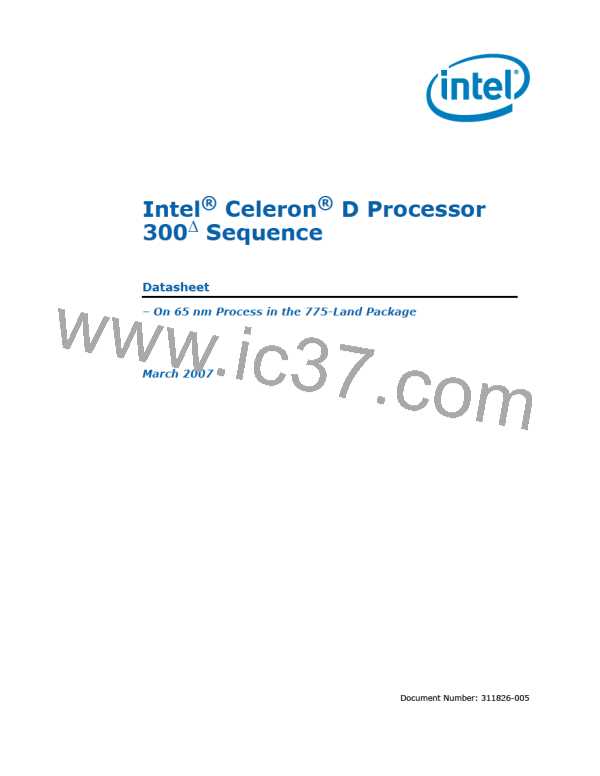Land Listing and Signal Descriptions
Table 25.
Signal Description (Sheet 1 of 9)
Name
Type
Description
The differential pair BCLK (Bus Clock) determines the FSB
frequency. All processor FSB agents must receive these signals to
drive their outputs and latch their inputs.
BCLK[1:0]
Input
All external timing parameters are specified with respect to the
rising edge of BCLK0 crossing VCROSS
.
BINIT# (Bus Initialization) may be observed and driven by all
processor FSB agents and if used, must connect the appropriate
pins/lands of all such agents. If the BINIT# driver is enabled during
power-on configuration, BINIT# is asserted to signal any bus
condition that prevents reliable future operation.
If BINIT# observation is enabled during power-on configuration, and
BINIT# is sampled asserted, symmetric agents reset their bus
LOCK# activity and bus request arbitration state machines. The bus
agents do not reset their IOQ and transaction tracking state
machines upon observation of BINIT# activation. Once the BINIT#
assertion has been observed, the bus agents will re-arbitrate for the
FSB and attempt completion of their bus queue and IOQ entries.
Input/
Output
BINIT#
If BINIT# observation is disabled during power-on configuration, a
central agent may handle an assertion of BINIT# as appropriate to
the error handling architecture of the system.
BNR# (Block Next Request) is used to assert a bus stall by any bus
agent unable to accept new bus transactions. During a bus stall, the
current bus owner cannot issue any new transactions.
Input/
Output
BNR#
This input is required to determine whether the processor is installed
in a platform that supports the Celeron D processor. The processor
will not operate if this signal is low. This input has a weak internal
pull-up to VTT.
BOOTSELECT
Input
BPM[5:0]# (Breakpoint Monitor) are breakpoint and performance
monitor signals. They are outputs from the processor which indicate
the status of breakpoints and programmable counters used for
monitoring processor performance. BPM[5:0]# should connect the
appropriate pins/lands of all processor FSB agents.
BPM4# provides PRDY# (Probe Ready) functionality for the TAP
port. PRDY# is a processor output used by debug tools to determine
processor debug readiness.
Input/
Output
BPM[5:0]#
BPM5# provides PREQ# (Probe Request) functionality for the TAP
port. PREQ# is used by debug tools to request debug operation of
the processor.
These signals do not have on-die termination. Refer to Section 2.5.2
for termination requirements.
BPRI# (Bus Priority Request) is used to arbitrate for ownership of
the processor FSB. It must connect the appropriate pins/lands of all
processor FSB agents. Observing BPRI# active (as asserted by the
BPRI#
BR0#
Input priority agent) causes all other agents to stop issuing new requests,
unless such requests are part of an ongoing locked operation. The
priority agent keeps BPRI# asserted until all of its requests are
completed, then releases the bus by de-asserting BPRI#.
BR0# drives the BREQ0# signal in the system and is used by the
processor to request the bus. During power-on configuration this
signal is sampled to determine the agent ID = 0.
Input/
Output
This signal does not have on-die termination and must be
terminated.
Datasheet
65

 INTEL [ INTEL ]
INTEL [ INTEL ]